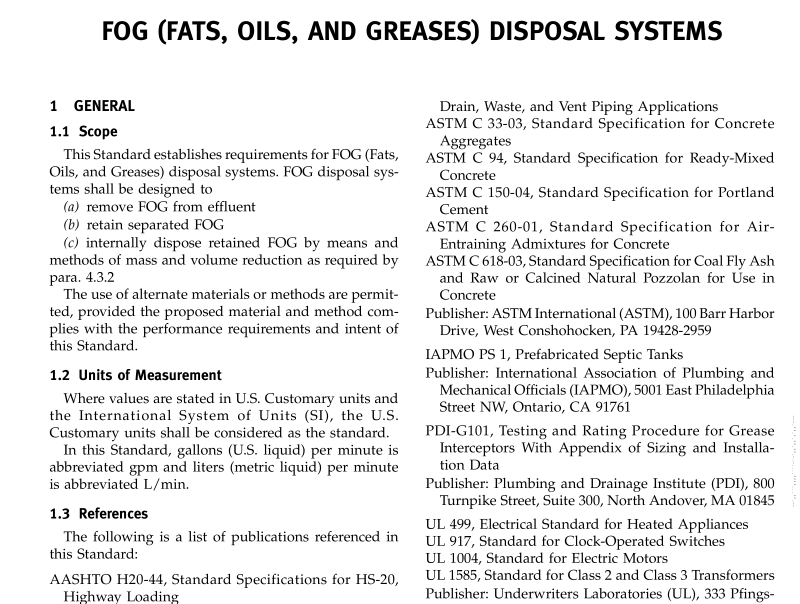ASME A112.14.6:2006 pdf free download FOG (Fats, Oils, and Greases) Disposal Systems
2.1.1 Design Performance. FOG disposal system designs and methods shall produce an effluent quality not to exceed 100 mg/L FOG as stated in para. 4.3.2. 2.1.2 Flow Rate. FOG disposal systems shall be described by total gpm influent.
2.1.3 Inlet and Outlet Connections. The inlet and outlet connections of the FOG disposal system shall be either a female pipe thread or a plain end diameter to allow hubless coupling connections. Tapered threads shall comply with ASME B1.20.1. Hubless connections shall comply with the outside dimension for the given pipe size in accordance with ASTM A 888 or ASME A112.3.1.
2.2 Electrical All electrical components used in the FOG disposal system shall conform to the appropriate sections of UL Standards 499, 917, 1004, and 1585 as listed in para. 1.3.
2.3 Manufacture
2.3.1 FOG disposal systems shall be free of manu- facture and/or material defects that affect performance, or serviceability.
2.3.2 FOG disposal systems shall be designed to withstand anticipated installation and use associated FOG loading.
2.3.3 Each FOG disposal system and cover desig- nated for buried application shall be structurally designed to withstand earth or other loads pertinent to its location.
2.3.4 FOG disposal systems and covers for buried applications in nonvehicular traffic areas shall be designed for an earth load of not less than 500 psf (24 kPa) when the maximum coverage does not exceed 3 ft (0.9 m).
2.3.5 FOG disposal systems and covers for installa- tion in traffic areas shall be designed to withstand an AASHTO H20-44 wheel load, an additional 3 ft (0.9 m) earth load with an assumed soil weight of 100 psf (4.8 kPa), and 30 psf (1.4 kPa) fluid equivalent sidewall pressure.
2.3.6 Internal construction shall be designed to withstand the maximum expected conditions that include, but are not limited to, chemical, thermal, elec- trostatic and hydrostatic pressure.
3 SPECIAL REQUIREMENTS
3.1 Separation/Retention Efficiency FOG disposal systems shall have a minimum separa- tion/retention efficiency in accordance with ASME A112.14.3 or PDI-G101. 3.2 Application Documentation Each FOG disposal system shall be provided with complete applicationinstructions including, butnotlim- ited to, the following:
(a) flow control and/or vent requirements
(b) any separate trapping requirements
(c) elevation and accessibility requirements
(d) safety and health-related instructions
(e) wiring instructions to reference national or local codes
(f) clean-out locations
(g) instructions that show the clearances required for maintenance, cleaning, and prevention of hazards 3.3 Maintenance and Operation Documentation Each FOG disposal system shall be provided with maintenance and operation documentation, which include a troubleshooting guide as well as instructions for performing necessary servicing or obtaining outside servicing. Units shall be provided with complete mainte- nance and operating instructions.
3.4 Installation
3.4.1 Installation shall be in accordance with the manufacturer’s recommendations and the applicable plumbing codes.
3.4.2 Each unit shall be packaged with illustrated directions detailing correct installation procedures.
3.4.3 In buried applications of FOG disposal sys- tems, access to each system shall be provided. There shall be access for each 10 ft (3.03 m) of length for FOG disposal systems over 20 ft (6.1 m) long. Each access opening shall have a leak-resistant closure (i.e., lid) that cannot slide, rotate, or flip exposing the opening, and which does not require the use of mechanical fasteners and be of a vandal-resistant type.
3.4.4 Manholes, ifapplicable,shall extendto grade; have a minimum diameter size of20 in. (510 mm) diame- ter or 20 in. ✕ 20 in. (510 mm ✕ 510 mm); and shall be provided with a fitted, water-tight cover. Manholes shall be capable of withstanding all anticipated loads and comply with IAPMO PS-1, para. 4.7.1, which requires thatall manholes have aleak-resistantclosure that, when properly installed, cannot slide, rotate, or flip exposing the opening, and which does not require the use of mechanical fasteners.
ASME A112.14.6:2006 pdf free download
